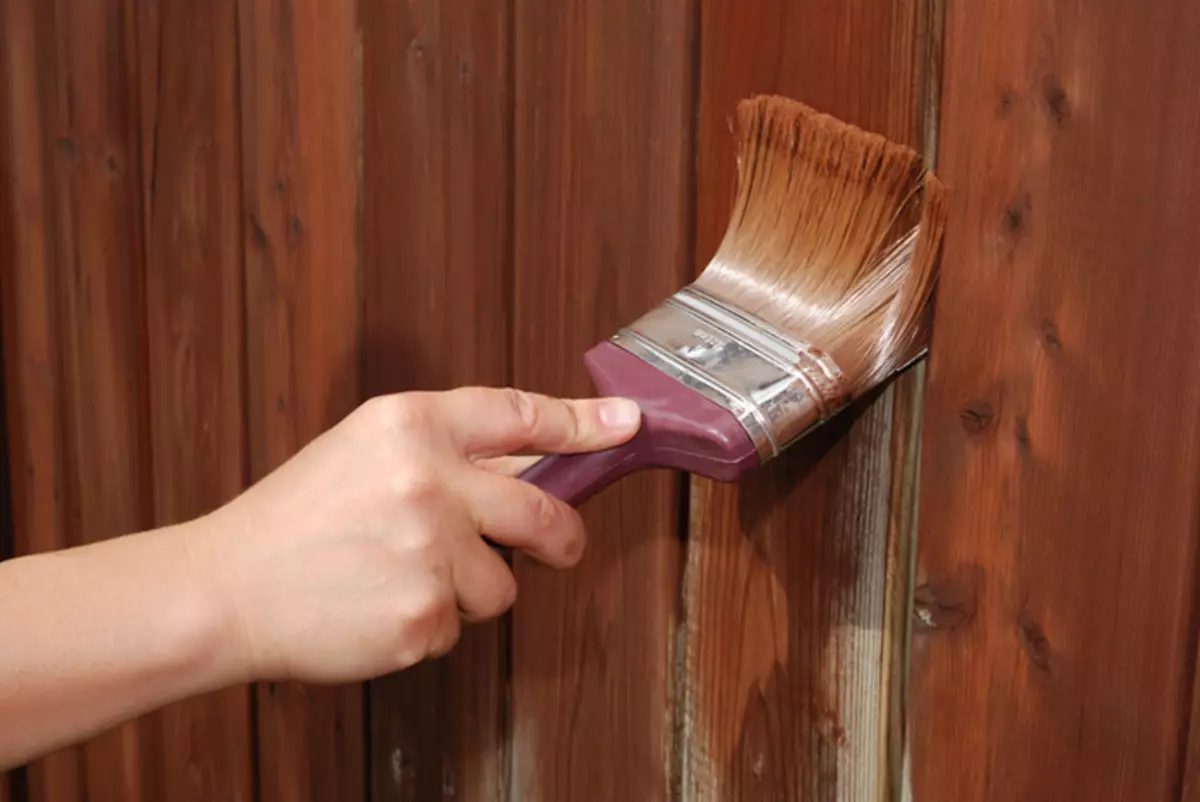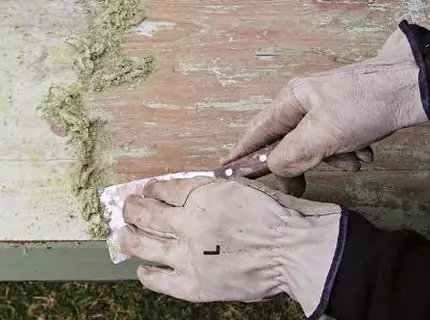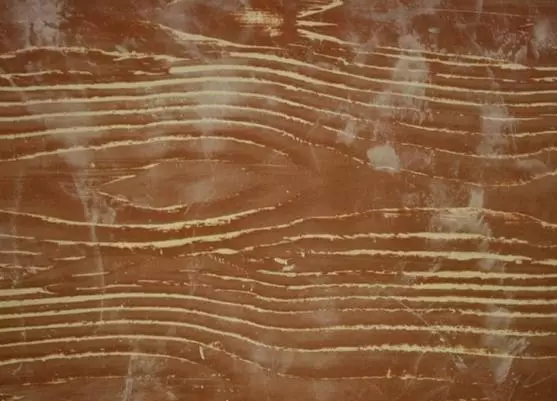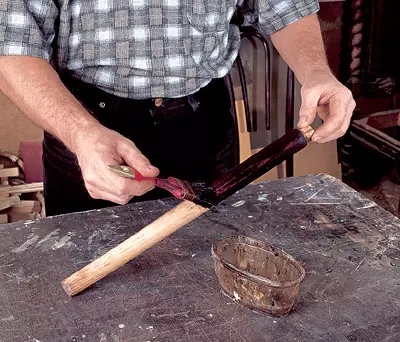The tree has always been and will be in demand, because it is natural, living material and no newcomer plastics can compete with it in creating the atmosphere of heat, good and comfort indoors. But like any living material, wood products require care and protection. For this purpose, special varnishes and veneers are widely used.

Lucky and vertices protect wooden products from dirt and scratches, as well as protect the wood from moisture penetration.
Treatment of wood with these means not only allows you to protect it from excess moisture, exposure to light, dirt, scratches and other adverse factors, but also gives sophistication and nobility, fixing and emphasizing the natural beauty of the drawing of the treated wood.
Removal of old coating
Apply the lacquer is always needed on a clean surface. If this is a new product, then no problems arise. But often there are cases when it is necessary to lacquer the painted tree, such as window frames, doors or wooden floors, the surface of which due to long-term operation is damaged. And if the integrity of the coating is broken, its protection is also broken. Therefore, before proceeding with new processing, you need to completely clean the surface from the layer of old varnish.
There are three main methods for cleaning wooden surfaces from an old coating: spicy with special solvents, thermal or mechanical impact. To determine which method is better to apply, it is necessary in each case individually, based on the type of product and used for its coating of materials.

The surface of the product is wetted by a solvent, then removed with a spatula.
With the first way, the old varnish is removed using special liquid solutions that the entire surface of the product is abundantly wetted. Immediately after processing, the product needs to be rooted or wrapped with a polyethylene film to create a thermos effect. After 24 hours, the film is removed and the spatula gently remove the old coating. If the coating is removed poorly, the entire procedure is repeated anew, and so until the wooden surface is completely clean.
When working with solvents, it is important to remember that they include poisonous substances. Therefore, they need to be applied in glasses, rubber gloves and respirator. At the end of cleaning, the tree is wiping with warm water and give it to dry out at least a day. After that, the surface is again grinning and ground. And only after that you can apply a new varnish.
Article on the topic: Table setting for the new year
With the second method, to remove the old coating, the tree is heated. At the same time, the varnish softened and it is easy to remove the spatula. Heated with a construction hairdryer, you can use a soldering lamp. But it is harder to work with her, because you need to constantly monitor that the tree does not overheat and not catch up. To secure it, it is better to monitor with water and only then to process.
The last way is more often used if you need to remove the old layer of varnish with a large area, such as a floor or a wooden terrace. Remove it with a grinding machine, and the remains of the varnish are removed by sandpaper.
Surface preparation

All slots on a wooden surface must be carefully covered and sandwiched.
Varnish can be applied only to the polished smooth surface. Regardless of whether the new material needs to be painted with varnish or old, it needs to be carefully examined. All detected seams, cracks and bitch must be processed and eliminated.
The discovered slots between the seams and joints should be sealing with a special putty. After applying putty, they give dry, and then to remove possible irregularities, covered areas are re-grinding small emery paper.
It is also necessary to take into account that the fact that the raw or even an inadvertent tree is pointless to splash, and even more so treat the olifa, the veil or varnish.
Hyd, the tree is deformed, and the applied layer will inevitably be damaged.
Features of the use of wood vehicles

The veil should be applied parallel to wood fibers, avoiding the contact of the layers.
For better protection of wooden products, they must be treated with a verse (impregnation). Morilka, penetrating deep into the pores of wood, enters into a chemical reaction with tanning substances in annual rings and gives a tree a resistant water and light-protective color. It also protects the tree from mold fungi, grouse beetles and other pests and infections. Modern liquid veils are divided into three groups: alcohol, oil and water.
Article on the topic: Replacing the entrance door in the apartment: Features and recommendations
Water verses are two types: in the form of ready-to-use solutions and in the form of a powder, from which such a solution needs to be prepared. This is the only look of the veil, who does not need White-alcohol, olifa and other solvents. The simulators of this group have one significant drawback: penetrating inside the tree, they raise its fibers, which makes a tree unprotected in front of an excess of moisture. Although, on the other hand, such treatment of wood allows to emphasize and highlight its structure. Therefore, today it is the most common type of verse.
The alcohol versicle is made in the same two species: in the finished form and in powder. It is not possible to apply this simile brush with a manually, but only from the collapse, as it dries almost in seconds.
Oil veil is the most convenient in work. It is easy to apply a uniform layer, it does not raise wood fibers and dries quickly. In addition, mixing in oil dyes, with its help you can give a tree almost any shade. Oil vehicles are bred by white alcohol or oil.
For the processing of wooden surfaces, the verses are used:
- painting brush;
- foam roller;
- Manual or automatic sprayer.
All of these boring tools are equal, and when choosing, you need to be guided solely common sense. For example, the Malary brush is a few dozen wooden floor squares for a very long time, and the windows of window frames, except for the brush, do not need anymore.
Morilka processing technique is no different from ordinary painting. The only condition: since most of the veneer will dry quickly, you need to work quickly, but neatly. It is important not to give the layer of stratum to dry up before the end of the work, otherwise it will be noticeably different from the rest of the seam. Therefore, it is impossible to dial a lot of solution on the brush.
They always apply the veil in parallel to the direction of the fibers of the tree. And you can not move to the processing of another figure or section, without finishing the work with the first. In places where two sections are connected, it is necessary to carefully monitor so that the stratified layers of the veneer do not impose on each other.
Wooden surface coating varnish
Depending on the method of manufacture, varnishes are divided into several types: alkyd, nitroleki, polyurethane, oil, acrylic and alcohol.
Article on the topic: 6 best producers of cast iron baths
Alkyd varnishes must be breeded by a solvent. The surface covered with them is protected from water and fire, does not fade in the sun. Acrylic varnishes create a film resistant to abrasion and slowing the aging of wood. Nitrolakes have a common with acrylic basis, but will dry much faster. However, they are not able to resist the impact of moisture and ultraviolet for a long time.
Polyurethane varnishes are characterized by increased wear resistance. Form a durable film on the surface of the tree, which will quickly dry. Suffice it to say that the wooden parts of the ships are treated with varnishes of this group.
Oil varnishes used to be very popular, but today they are used mainly to handle floor. The main advantage is low, in comparison with other types of varnishes, the price. They require compulsory breeding of Olife and dry long.
Acrylic varnishes appeared relatively recently. Today it is the most universal and convenient to use wood varnish. They can be performed both internal and outdoor work. Washed water and does not have a sharp smell characteristic of other groups. In its protective properties, alkyd varnishes are similar to alkyd varnishes, but much more economically in use.
Alcohol varnishes are used exclusively for the restoration of antique furniture.
The technique of applying varnish is similar to the technique of wood processing by the Morilka. You will need a roller or painting brush to work. Sometimes, if you need to handle hard-to-reach places, a foam sponge is used. Recently, the popularity of the lacquer spray in the canopy is won, for the application of which no tools do not need. But the flow rate of such a varnish is much more against the traditional.
Usually varnish is applied in 2-3 layers. Regardless of the type of varnish and its texture, the layers need to be done thin, otherwise the acids will be visible on the painted surface. The decision to work with a roller or brush depends solely on the scope of work and your preferences.
Works on the processing of wooden surfaces by the vessel and the coating of their lacquer do not require special qualifications from the performer, therefore, forces anyone who wants. The main thing is to have enough patience and doctrity. And then the tree in your house will be happy to please the eyes with a noble brilliance and chic appearance.
Good luck!
